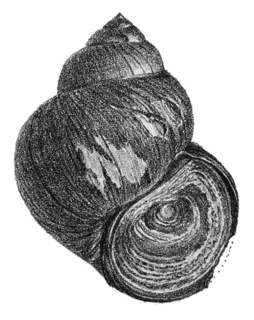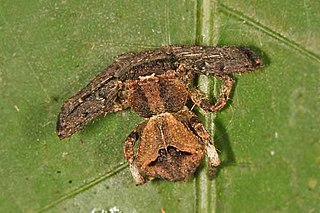
Scaffold web spiders (Nesticidae) is a family of araneomorph spiders closely allied with tangle web spiders. Like the "Theridiidae", these spiders have a comb of serrated bristles on the hind tarsi that are used to pull silk bands from the spinnerets. It contains 16 genera and about 300 species, many of which are associated with caves or overhangs. The genus Nesticus is the type for the family and is found throughout the world. The related Eidmannella has speciated considerably in Texas caves and includes some extremely localized species that are considered threatened. One species, Eidmannella pallida, is found in caves and under overhangs, but also in agricultural fields and other habitats away from such restricted areas. The genus Carpathonesticus is found in central Eurasia.

Oreonectes is a genus of fish in the family Nemacheilidae found in the rivers and cave of Asia. Many of these species are troglobitic.

Triplophysa is a genus of fish in the family Nemacheilidae found mainly in and around the Qinghai-Tibet Plateau in China. Currently, the genus is a mixed assemblage of species. Some lineages have been identified and treated as subgenera, but as Wikipedia follows Fishbase for fish species these have been treated as subgenera in Wikipedia, although Kottelat and the Catalog of Fishes treat them as genera. FishBase, however, includes these in Triplophysa without specifying subgenera and treats the names given by Kottelat as synonyms.
Pareuchiloglanis is a genus of sisorid catfishes native to Asia. These species are rheophilic catfish chiefly found in the headwaters of major rivers in South and East Asia. They originate from the Brahmaputra drainage in India, east and south to the Yangtze drainage in China and the Annamese Cordillera drainages in southern Vietnam. Two species are known from the Mekong River: P. myzostoma and P. gracilicaudata. Four species are known from the drainage of China: P. abbreviatus, P. gracilicaudata, P. myzostoma and P. prolixdorsalis.

Alcimochthes is a genus of Asian crab spiders that was first described by Eugène Louis Simon in 1885. As of June 2020 it contains three species, found in eastern Asia: A. limbatus, A. melanophthalmus, and A. meridionalis.
Sinopimoa is a monotypic genus of Chinese sheet weavers containing the single species, Sinopimoa bicolor. It was first described by S. Q. Li & J. Wunderlich in 2008, and is found in China. It was originally placed in its own family (Sinopimoidae) but is now considered a member of the Linyphiidae, and it may be a member of the Erigoninae.

The Tiaojishan Formation is a geological formation in Hebei and Liaoning, People's Republic of China, dating to the middle-late Jurassic period. It is known for its exceptionally preserved fossils, including those of plants, insects and vertebrates. It is made up mainly of pyroclastic rock interspersed with basic volcanic and sedimentary rocks. Previously, the Tiaojishan Formation was grouped together with the underlying Haifanggou Formation as a single "Lanqi Formation." Most researchers now agree that the Daohugou Bed, of formerly controversial dating, is a part of the Tiaojishan formation. The Tiaojishan Formation forms a key part of the Yanliao Biota assemblage.

The Yixian Formation is a geological formation in Jinzhou, Liaoning, People's Republic of China, that spans about 5 million years during the early Cretaceous period. It is known for its fossils, listed below.

Cipangopaludina cathayensis is a species of large, freshwater snail with an operculum and a gill, an aquatic gastropod mollusk in the family Viviparidae, the river snails.
Bannaella is a genus of East Asian cribellate araneomorph spiders in the family Dictynidae, and was first described by Z. S. Zhang & S. Q. Li in 2011. As of May 2019 it contains only three species, all found in China: B. lhasana, B. sinuata, and B. tibialis.
Chinophrys is a genus of jumping spiders that was first described by J. X. Zhang & Wayne Paul Maddison in 2012.
Sinoinsula is a genus of Chinese jumping spiders that was first described by Y. Y. Zhou & S. Q. Li in 2013.

Angaeus is a genus of Asian crab spiders first described by Tamerlan Thorell in 1881. It is considered a senior synonym of Paraborboropactus.
Troglocoelotes is a genus of funnel weaver spiders first described in 2019 by Zhao & Li.
Hengconarius is a genus of funnel weavers first described by Zhao & S. Q. Li in 2018.
Nuconarius is a genus of funnel weavers first described by Zhao & S. Q. Li in 2018. As of March 2019 it contains only three species.
Eupoinae is a subfamily of jumping spiders. It was created in 2015 by Wayne Maddison. The subfamily has three genera.
Dendroicius is a genus of spiders in the jumping spider family Salticidae with the sole species Dendroicius hotaruae, found in China. It was first described in 2020 by Y.J. Lin and S.Q. Li. The authors did not place the genus into a taxon within the Salticidae, other than distinguishing it from Icius.
Megaeupoa is a genus of spiders in the jumping spider family Salticidae.







